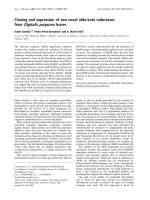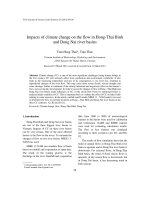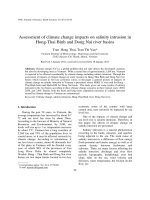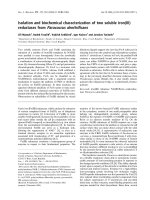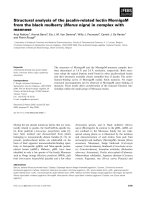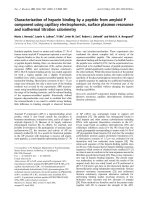Interaction of two heterocyclic Schiff bases derived from 2-acetyl pyridine on mild steel in hydrochloric acid: Physicochemical and corrosion inhibition investigations
Bạn đang xem bản rút gọn của tài liệu. Xem và tải ngay bản đầy đủ của tài liệu tại đây (2.07 MB, 12 trang )
Current Chemistry Letters 9 (2020) 19–30
Contents lists available at GrowingScience
Current Chemistry Letters
homepage: www.GrowingScience.com
Interaction of two heterocyclic Schiff bases derived from 2-acetyl pyridine on
mild steel in hydrochloric acid: Physicochemical and corrosion inhibition
investigations
M. Paulson Binsia, Thomas K. Jobya*, K. Ragia, Varghese C. Sinia and Johnson Reejaa
a
Research division, Dept. of Chemistry, St. Thomas’ College(Autonomous), Thrissur, Kerala – 68000, India
CHRONICLE
Article history:
Received March 13, 2019
Received in revised form
June 17, 2019
Accepted June 17, 2019
Available online
June 17, 2019
Keywords:
Schiff base
Corrosion Inhibitor
Polarization
Impedance
Adsorption
ABSTRACT
Two heterocyclic Schiff bases namely (E)-2-(1-(2-phenylhydrazono)ethyl)pyridine (or 2acetyl pyridine phenyl hydrazone) (2APPH) and (E)-2-(1-triazylidineethyl)pyridine (or 2acetyl pyridine semicarbazone) (2APSC) were synthesized, characterized and their corrosion
inhibition behaviour as well as mechanism of inhibition were investigated by different
techniques. Structural characterization includes NMR, Mass, IR and UV-visible spectroscopy
and elemental analysis. Corrosion inhibition behaviour of aforesaid compounds on mild steel
in 1M hydrochloric acid was examined by electrochemical methods including potentiodynamic
polarization analysis and electrochemical impedance spectroscopic techniques. The
mechanism of corrosion inhibition was explored and supplemented by adsorption and surface
morphological studies. Quantum mechanical investigations on corrosion behaviour of
compounds were also conducted and satisfying correlation was noticed between the results of
corrosion measurement methods and quantum mechanical evaluations.
© 2020 by the authors; licensee Growing Science, Canada.
1. Introduction
The study of Schiff bases was considered as predominant research area to prevent the metal
corrosion, since it is an important threat which can affect directly or indirectly on the economy1-4.
Corrosion is the deterioration of metals and alloys by chemical or electrochemical means. Corrosion is
considered as a universal phenomenon, omnipresent and omnipotent. In industrial fields, de-scaling,
pickling etc. commonly employed for the metal surface cleaning, demands enormous amount of HCl
and leads to metal disintegration. Many organic compounds containing azomethine (C=N) linkage act
as corrosion inhibitor in acid media5-10. Schiff bases are organic compounds containing azomethine
linkage and have many applications in corrosion science. The hetero atoms present in these molecules
are responsible for the corrosion inhibition property for mild steel (MS), aluminium, copper and zinc
in acid media11-18.
The present investigation was done to examine the corrosion inhibition efficiency and mechanism
of two novel heterocyclic Schiff base molecules derived from 2-acetyl pyridine on MS in 1M HCl
solution. The experimental study was performed by different corrosion monitoring methods such as
electrochemical investigations including polarization analysis and electrochemical impedance
* Corresponding author. Tel.: 8129822232
E-mail address: (T. K. Joby)
© 2020 by the authors; licensee Growing Science, Canada
doi: 10.5267/j.ccl.2019.006.005
20
spectroscopic method. The corrosion inhibition mechanism of the compounds was confirmed by
adsorption studies and surface morphological analysis. Quantum mechanical investigations on
corrosion inhibition using Gammess software were also performed.
2. Results and Discussion
2.1. Physicochemical discussions
2APPH: Elemental analytical data calculated: C, 73.9; H, 6.16; N, 19.90%. Found: C, 73.6; H,
6.12; N, 19%. Melting point: 220°C. The 1Hnmr spectrum of the Schiff base 2APPH exhibited nine
clear peaks. The methyl protons displayed a peak at 2.42δ. A weak broad peak exhibited at 10.48 δ was
due to the NH proton and the broadness of the peak can be explained by the effects of H-bonding and
quadrupole broadening. The peaks appeared in the range 7.78- 8.72 δ were assigned to the pyridine ring
aromatic protons.
In the 13Cnmr spectrum a peak appeared at 12.1ppm assigned to methyl carbon
atom and all 10 different type sp2 hybridized carbon atoms on aromatic ring exhibited their signals in
the range 114-149ppm. Mass: Base peak at 211 (M +). The clear signals appeared at m/z 196, 194 and
106 were assigned due to the fragments [C12H10N3]+, [C12H8N3]+ and [C6H6N2]+ respectively. IR: 1606
cm−1 (C=N), 3343 cm−1 (-N-H). UV-vis: 28901cm-1 (nπ*), 32680cm-1 (π π*) and 39216cm-1 (ππ*).
2APSC: Elemental analytical data calculated: C, 53.93; H, 5.61; N, 31.46. Found: C, 53.46; H, 5.45;
N, 31.39. Melting point: 200°C. The eight distinct non equivalent protons of 2APSC exhibited eight
clear peaks on 1Hnmr spectrum. The three protons on sp3 hybridized carbon atom (CH3) showed its
characteristic peak at 2.31δ. A broad peak observed at 3.9 δ is assigned to the NH2 protons and the
broadness of the peak can be explained by the effects of H-bonding and quadrupole broadening. The
NH proton exhibited a peak at 10.167 δ and the peaks appeared in the range 7.91- 8.80 δ were assigned
to the aromatic protons. A very weak peak appeared at 6.18 δ can be assigned to the –OH proton, which
generates by the mechanism of tautomerism. In the 13Cnmr spectrum the peaks appeared at 12.02ppm
and 156ppm were displayed by methyl carbon atom and carbonyl carbon atom respectively. Mass: m/z
at 178 (M+). The base peak observed at m/z 134 is assigned to the fragment [C7H8N3]+, which was
generated the removal of amide group from the molecular ion. The clear signals appeared at m/z 106,
78 and 51 were assigned due to the fragments [C7H8N]+, [C5H4N]+and [C4H3]+ respectively. IR: 1608
cm−1 (C=N), 3176 cm−1 (-N-H). UV-vis: 29142cm-1 (nπ*), 34013 cm-1 (π π*) and 39370cm-1 (ππ*).
2.2. Corrosion Inhibition Studies
2.2.1. Gravimetric studies
Weight loss analysis of mild steel was performed by immersing metal coupons of 1 cm 2 area in 1 M
HCl solution for 24hrs without and with the prepared Schiff bases at different concentrations. The
percentage of inhibition of the prepared Schiff bases 2APPH and 2APSC are recorded in the table 1.
From the analytical studies conducted it is evident that there is a significant increase in the corrosion
inhibition efficiency with the introduction of Schiff bases in different concentrations in the corroding
1M HCl solution for the mild steel examined. Thus the prepared Schiff bases under study have the
capacity to efficiently inhibit metallic disintegration of mild steel in the acidic medium even at very
low concentration. The inhibiting Schiff bases 2APPH and 2APSC exhibited more than 80 percent
inhibition efficiency at all examined concentrations as evident from the experimental results. However,
inhibitor 2APPH performed marginally higher efficiency at all concentrations and a maximum
inhibition efficiency of 95.64% was achieved at 1mM concentration.
M. P. Binsi et al. / Current Chemistry Letters 9 (2020)
21
Table 1. Inhibition efficiency of mild steel in the presence and absence of 2APPH and 2APSC in
1M HCl for 24hrs
Con (mM)
Schiff base
0.2
0.4
0.6
0.8
1
2APPH
88.99
91.43
94.31
95.09
95.64
2APSC
81.12
86.98
89.23
91.64
94.71
2.2.2
Electrochemical Impedance Spectroscopic studies (EIS)
The corrosion behaviour of MS in 1 M HCl without and with inhibitor was examined using
impedance spectroscopic analysis at 300C. Fig. 1 and Fig. 2 represent the Nyquist plots and Bode plots
of two Schiff bases 2APPH and 2APSC respectively. The impedance parameters including double layer
capacitance (Cdl), solution resistance (Rs) and percentage of inhibition efficiency (ηEIS%) were evaluated
from the values of charge transfer resistance (Rct) and tabulated in Table 1. At both higher and lower
frequencies the capacitance loop intercepts the real axis. These intercepts at the high frequency end
represents the solution resistance (Rs) and at the lower frequency end represent the sum of Rs and Rct.
The difference between these intercepts can be calculated to find out Rct which is the measurement of
the electron transfer that takes place on the exposed metallic surface under analysis and is inversely
proportional to the corrosion rate of the surface.
The study of impedance behaviour was carried out by electric models which helped to evaluate
numerical measurements for the chemical and physical properties of the corresponding electrochemical
system under investigation. The equivalent circuit that exactly fit to the EIS curves generally consisted
of a double solution resistance Rs, charge transfer resistance Rct and double layer capacitance Cdl (Figure
3). Generally, all the Nyquist plots were observed in semicircles and showed some irregularities which
can be ascribed to the non-homogeneous nature or roughness of the metal surface. From the Table 2,
it was observed that along with the increasing of the inhibitor concentration, Cdl values were decreased
and Rct values were increased in the case of both inhibitors. The variation in Rct values can be explained
by the adsorption process by which the inhibition mechanism takes place. As the inhibitor concentration
increases there would be a considerable increase in the amount of adsorption process. It is due to the
prevention of the charge transfer of the metal atoms on the metallic surface and solution by adsorbed
molecules resulting in raising the charge transfer resistance with increasing inhibitor concentration.
The lowering of Cdl values with increase in the inhibitor concentration can be associated with the
reduction of local dielectric constant values and rise in the thickness of electrical double layer. These
observations testify the inhibitor action at the solution–metal interface.
Table 2. Electrochemical impedance parameters of MS corrosion with and without Schiff bases 2APPH
and 2APSC in 1M HCl
Schiff base
C(mM)
Rct(ᾨcm2)
Cdl
ƞEIS%
0
59.7
98.9
0.2
342
94.1
82.54
2APPH
0.4
359
77.9
83.30
0.6
395
77.6
84.88
0.8
445
66.9
86.58
1
826
54.5
92.70
0.2
231
102
74
0.4
267
85.2
77.64
2APSC
0.6
317
84.7
81.16
0.8
413
82.4
85.54
1
470
81.6
87.29
22
(a)
(b)
Fig. 1. a) Nyquist plots and b) Bode plots of MS corrosion with and without 2APPH in 1M HCl
(a)
(b)
Fig. 2. a) Nyquist plots and b) Bode plots of MS corrosion with and without 2APSC in 1M HCl
Fig. 3. Equivalent circuit for EIS measurements
From the data it is obvious that both Schiff bases 2APPH and 2APSC act as potential corrosion
inhibitors in hydrochloric acid media. Both of them exhibited above 70% efficiency of corrosion
inhibition and a maximum efficiency of inhibition, 92.7% was obtained for 2APPH at concentration of
1mM. The efficiency of inhibition of the two Schiff bases derived from 2-acetyl pyridine obeys the
order 2APPH > 2APSC.
2.2.3 Potentiodynamic polarization studies
Tafel extrapolation analysis and linear polarization studies were conducted to establish the impact
of Schiff base compounds towards the polarization of metal specimens by the determination of
polarization resistance, corrosion current density and the percentage of inhibition efficiencies. Tafel
polarization curves and linear polarization curves obtained for the different concentrations are
represented in the Fig. 3 and Fig. 4. The corrosion parameters -corrosion potential (Ecorr), corrosion
M. P. Binsi et al. / Current Chemistry Letters 9 (2020)
23
current density (Icorr), polarization resistance (Rp) and inhibition efficiency percentage (ηpol %) are listed
in Table 3.
Table 3. Polarization data for MS corrosion with and without inhibitors 2APPH and 2APSC in 1M
HCl
Schiff
Bases
2APPH
2APSC
Con
(mM)
Ecorr
(mV/SCE)
Tafel Data
Icorr
(μA/cm2)
ba
(mV/dec)
-bc
(mV/dec)
ηpol%
0
0.2
0.4
0.6
0.8
1
0
0.2
0.4
0.6
0.8
1
-498
-458
-425
-455
-460
-450
-498
-456
-451
-460
-453
-448
360
110.8
103.9
87
66.4
34.4
360
66.6
56.2
55
54.2
53.2
122
86
75
81
72
61
122
71
64
66
67
62
150
188
166
191
164
143
150
163
155
144
150
162
69
71
76
82
90
82
84.3
84.7
84.9
85.2
(a)
Polarization Data
Rp
ηRp
(ohm)
%
83.23
232
215.4
282.8
327.8
542.8
83.23
321.6
351.8
358.4
370.4
367.7
64
61
70
75
85
74
76
76.7
77.5
77.7
(b)
Fig. 3. a)Tafel plots and b)linear polarization curves for MS corrosion with and without of 2APPHin 1M HCl
(a)
(b)
Fig. 4. a)Tafel plots and b)linear polarization curves for MS corrosion with and without of 2APSC in 1M HCl
Tafel data analysis elucidates that the values obtained for corrosion current density (Icorr) were
significantly decreased and high inhibition efficiencies were obtained in presence of both inhibitors in
24
1M HCl even at low concentrations. A closer examination clarified that the Schiff base 2APPH
displayed more efficiency on MS surface as compared to 2APSC and a maximum inhibition efficiency
of 85% achieved by 2APPH at 1 mM concentration. This is also congruent with the data obtained in
gravimetric analysis and EIS measurements. In the cases of both Schiff bases 2APPH and 2APSC the
cathodic slopes exhibited predominant changes than the anodic slopes which is a clear evidence for
relatively higher adsorption of these Schiff bases on the cathodic sites. Furthermore, the E corr value was
not altered (>85) with respect to Ecorr of blank experiment with the appreciable change in anodic or
cathodic slopes in both the Schiff bases suggesting that in 1M HCl they are mixed type inhibitors for
MS.
2.2.4
Adsorption studies
The mechanism of adsorption of the Schiff base under study represented in figure 6 and their surface
modifications can be described by invoking suitable adsorption isotherms in which the commonly used
ones are Langmuir, Temkin, Frumkin and Freundlich isotherms19-23. Evaluation of adsorption
parameters is done by selecting the best fit isotherm model assisted by the correlation coefficient (R2).
Fig. 5 represents the adsorption isotherms for the compounds 2APPH and 2APSC in 1M HCl. The
adsorption behaviour of both 2APPH and 2APSC on MS specimens in 1M HCl were obtained from
Langmuir adsorption isotherm and it can be expressed as
𝐶
1
=
+𝐶,
θ 𝐾
where C is the concentration of inhibitor, θ is the fractional surface coverage and Kads is the value of
adsorption equilibrium constant. This adsorption equilibrium constant, Kads mainly depends on the
standard free energy of adsorption ∆G0ads, by the following relationship,
∆𝐺
= −𝑅𝑇 ln(55.5 𝐾
)
where 55.5 is the molar concentration of water, R is the ideal gas constant and T is the temperature in
Kelvin.
R2 = 0.999
0
0.5
1
C(mM)
(a)
1.5
0.0012
0.001
0.0008
0.0006
0.0004
0.0002
0
C/Ɵ
C/Ɵ
0.0012
0.001
0.0008
0.0006
0.0004
0.0002
0
R2 = 0.998
0
0.5
1
C(mM)
1.5
(b)
Fig. 5. Langmuir adsorption isotherms for a) 2APPH and b) 2APSC on MS in 1M HCl
The adsorption equilibrium constant Kads represents the measurement of the adsorption taking place
on the corresponding surface. The Schiff base 2APPH has Kads value 33333, which is comparatively
higher than Kads value 20000 of 2APSC. It implies that the efficacy of adsorption of 2APPH is greater
than that of 2APSC. The ∆G0ads values obtained for 2APPH and 2APSC are -36.13 and -34.85 KJ/mol
respectively. The ∆G0ads values up to -20kJ mol-1 indicates clearly the electrostatic attraction or
physisorption between a charged molecule and a charged metal surface whereas those more negative
than -40kJ mol-1 indicates the strong adsorption of the inhibitors on metallic surface through strong coordinate bonds or chemisorption.
M. P. Binsi et al. / Current Chemistry Letters 9 (2020)
25
Fig. 6. Corrosion inhibition mechanism of Schiff base molecules on MS surface
2.2.5
Surface morphological studies
To verify the inhibition mechanism of investigated Schiff base compounds on the MS surface,
morphological studies were conducted by taking SEM images of steel surfaces 24,25. represents the
SEM images of bare sample, metal immersed in 1M HCl, and metal immersed in 1M HCl containing
1M 2APPH. On close examination of figures it was evident that the MS surface was highly corroded
in blank HCl solution. Small cracks and pits on the bare metal surface generated by the surface
polishing were totally disappeared on the metal surface dipped in acid solution in the absence of Schiff
base due to the intensive corrosion. The comparison of figures established that the surface damaging
was appreciably decreased in the presence of 2APPH, which indicates that the corrosion tendency was
considerably suppressed due to the formation of a protective film of 2APPH through adsorption.
(a)
(b)
(c)
Fig. 7. a) bare sample b) metal immersed in 1M HCl c) metal immersed in 1M HCl containing 1M
2APPH
2.2.6 Quantum mechanical analysis
The corrosion inhibition efficacy of Schiff base inhibitors can be correlated with the frontier
molecular orbital energies. The HSAB concept (donor-acceptor interaction) between the vacant orbitals
of Fe atoms and the filled molecular orbitals of the inhibitor compounds has an important role in the
prevention mechanism of metal disintegration. The lowest 𝐸LUMO − 𝐸HOMO (Δ𝐸) value of inhibitors is
the essential quantum mechanical parameter which helps them to bind on the metal surface strongly.
Quantum mechanical evaluations were carried out using DFT method by GAMMES software.
Calculated quantum mechanical parameters like 𝐸HOMO, 𝐸LUMO, Δ𝐸, electronegativity (𝜒), hardness (𝜂)
and number of transferred electrons (Δ𝑁) for the investigated inhibitors are tabulated in table 4. The
HOMO and LUMO pictures of the inhibitors are represented in the figures 8 and 9 respectively. The
Δ𝐸 between HOMO and LUMO is comparably low for 2APPH than 2APSC, which imply that 2APPH
have predominant inhibition efficiency. These data indicate that the energy required to move electrons
from HOMO of 2APPH to the vacant orbitals of Fe is very low. The Δ𝑁 values corresponding to the
electron transfer from donor to acceptors are also evaluated from these quantum mechanical parameters
26
which provide the information about interaction with the metal atoms. Optimized structures of
compounds, established quantum mechanically, are represented in the figure 10. The calculations are
conducted using following equations,
χ ≈ -1/2 (EHOMO + ELUMO )
∆𝑁 =
η ≈ 1/2 (EHOMO - ELUMO )
(ƞ
ƞ
)
Table 4. Quantum mechanical parameters of the Schiff base inhibitors on MS
Inhibitor
𝐸HOMO(eV)
𝐸LUMO(eV)
Δ𝐸 (eV)
𝜒
2APPH
-3.2653
1.0612
4.3265
1.1020
2APSC
-3.5919
1.1156
4.7075
102381
(a)
(b)
Fig. 8. HOMO of a) 2APPH b) 2APSC
(a)
(b)
Fig. 9. LOMO of a) 2APPH b) 2APSC
(a)
(b)
Fig. 10. Optimized structures of a) 2APPH b) 2APSC
𝜂
2.1632
2.3537
Δ𝑁
1.36
1.22
M. P. Binsi et al. / Current Chemistry Letters 9 (2020)
27
3. Conclusion
Both studied Schiff bases 2APPH and 2APSC displayed predominant corrosion inhibition efficiency
on MS in 1M HCl medium. According to the electrochemical analysis, corrosion inhibition efficiency
of the studied compounds followed the order 2APSC < 2APPH. The higher efficiency of 2APPH was
explained by the presence of two aromatic ring systems in the molecule. Both compounds obeyed
Langmuir adsorption isotherm on MS surface. Surface morphological analysis revealed that the studied
compounds form a protective barrier on MS surface and resist the metallic disintegration appreciably.
Quantum mechanical investigations using Gammess software was also established that 2APPH
possesses relatively higher corrosion inhibition capacity.
4. Experimental analysis
4.1. Synthesis
Heterocyclic hydrazones were synthesized by the condensation reaction of equimolar amounts of
2-acetylpyridine and amino compounds such as phenyl hydrazine and semicarbazide in ethanol
medium. The resulting solutions were concentrated and the separated crystals were collected and
washed with ethanol. Recrystallization from methanol gave the desired products. The products were
characterized by elemental (Vario EL III Element Analyzer) analysis, mass (Shimadzu,QP 2010
GCMS), nmr ( Bruker Avance III HD, CDCl3 solvent), IR (Shimadzu affinity-1, KBr pellet method)
and UV spectroscopic analyses
O + H2N
H
N
N
EtOH
3h, reflux
2-acetyl pyridine
Phenyl hydrazine
2-acetyl pyridine
Semicarbazide
N
H
N
N
2APPH
2APSC
4.2. Physicochemical Investigations
C H N analysis: Carbon, hydrogen and nitrogen percentage of the Schiff bases were measured by
microanalysis using Elementar make Vario EL III model CHN analyzer. Infrared spectra: The infrared
spectra of the Schiff base compounds were recorded by KBr pellet method in the range of 4000-400cm 1 on Shimadzu model FT-IR Spectrometer (Model IR affinity-1). The infrared spectra contain the
characteristic stretching frequencies which help to predict the functional groups present in the
compounds. Electronic spectra: The electronic spectra of the Schiff bases were recorded on a Shimadzu
UV-Visible-1800 Spectrophotometer with DMSO as solvent. The obtained data gives additional
evidence for the molecular structure of Schiff bases. Mass spectra: The mass spectral studies were
carried out only after the removal of the impurities present in trace amount by chromatographic method.
Mass spectra were recorded using Gcms Qp-2010 plus model. NMR spectra: 1Hnmr and 13Cnmr studies
of the compounds were recorded in CDCl3 and DMSO solvent using Bruker Avance lll, 400MHz
model.
4.3. Gravimetrical measurements
The gravimetric measurements were carried out using ASTM standard method. Mild steel metal
specimens of approximate composition C,0.42%; Mn,0.05%; P,0.01%; S,0.016%; Si,0.025% and rest
28
Fe were used for the studies. The weight loss happened for the metal specimens were calculated for 24
hours. A blank measurement was also taken without inhibitor addition. From weight loss measurements
corrosion rate and percentage of corrosion inhibition efficiency was determined. The corrosion rate and
the inhibition efficiency of compounds were calculated using Eq. (1) and Eq. (2), respectively.
Rate of corrosion W =
K × wt. loss in grams
,
Area in sq. cm × time in Hrs × Density
(1)
where ‘K’ = 87600 (This is a factor used to convert cm/hour into mm/year), density of MS specimen =
7.88g/cc and the density of Cu = 8.76g/cc
Percentage of inhibition or the inhibition efficiency (η) is given by
W − W′
Inhibition efficiency η =
× 100,
W
(2)
where W & W’ are the corrosion rate of the MS specimen with and without the inhibitor respectively.
4.4. Electrochemical measurements
The steel samples used for the electrochemical studies were abraded with different grades of silicon
carbide paper, washed and dried. Different inhibitor solutions were prepared in the concentrations range
of 0.2–1.0mM in 1M HCl medium. Electrochemical studies were carried out using three electrode cell
assembly consisting of MS as working electrode (exposed area 1cm 2), platinum electrode as counter
electrode (1cm2) and saturated calomel electrode (SCE) as reference electrode at 300C. For acid
corrosion the working area of metal specimens were exposed to the electrolyte for 30 min prior to the
experiment. Ivium Compact state electrochemical system together with Iviumsoft software package
was used to perform the experiments.
4.4.1 Electrochemical Impedance Spectroscopic studies (EIS)
EIS measurements are were taken at constant potential in the frequency range from 1KHz to 100
mHz with amplitude of 10 mV as excitation signal 26-28. The percentage of inhibition calculated by the
following equation,
η
%=
R −R
R
× 100
where Rct and R’ct are the charge transfer resistances of working electrode in the presence and absence
of inhibitor, respectively.
4.4.2. Potentiodynamic Polarization studies
A potential range of +250 to -250 mV with a sweep rate of 1mV/s was used for the study29. Slope
analysis of Tafel curves gave the corrosion current densities and the inhibition efficiency was calculated
by the following equation
I
−I
η %=
× 100,
I
where Icorr and I’corr are corrosion current densities of the exposed area of steel rebar in the absence
and presence of inhibitor respectively.
4.5. Surface Morphological analysis
The analysis of changes observed in the surface morphology of the metal surface helps to explain
the inhibition mechanism by which the Schiff bases decrease the corrosion rate. This was carried out
by recording scanning electron micrographs (SEM) of the surfaces of bare metal, metal immersed in
M. P. Binsi et al. / Current Chemistry Letters 9 (2020)
29
acid solution (48 h) and metal immersed in inhibitor solution (24 h). It was taken by the model JEOL
model JSM-6390LV in the resolution value 2.00 x.
4.6. Quantum Mechanical evaluations
GAMMES software and DFT method were used for the determination of optimized geometry of
compounds and quantum chemical evaluations. A combination of Lee–Yang–Parr nonlocal correlation
functional (B3LYP) and Beck’s three parameter exchange functional was employed in DFT method 3032.
References
1.
2.
3.
4.
5.
6.
7.
8.
9.
10.
11.
12.
13.
14.
Chaitra T. K., Mohana K. N., Gurudatt D. M., & Tandon H. C. (2016) Inhibition activity of new
thiazole hydrazones towards mild steel corrosion in acid media by thermodynamic, electrochemical
and quantum chemical methods. J. Taiwan Inst. Chem. Eng., 67, 521–531.
Negm H. C., Elkholy Y. M., Zahran M. K., & Tawfik S. M. (2010) Corrosion inhibition efficiency
and surface activity of benzothiazol-3-ium cationic Schiff base derivatives in hydrochloric acid.
Corros. Sci., 52, 3523–3536.
Hegazy M. A., Hasan A. M., Emara M. M., Bakr M. F., & Youssef A. H. (2012). Evaluating four
synthesized Schiff bases as corrosion inhibitors on the carbon steel in 1 M hydrochloric acid.
Corros. Sci. 65, 67–76
Issaadi S., Douadi T., Zouaoui A., Chafaa S., & Khan M.A. (2011). Novel thiophene symmetrical
Schiff base compounds as corrosion inhibitor for mild steel in acidic media. Corros. Sci. 53, 1484–
1488.
Singh P., & Quraishi M. A. (2016). Corrosion inhibition of mild steel using Novel Bis Schiff's
Bases as corrosion inhibitors: electrochemical and surface measurement. Measurement, 86, 114–
124.
Ekpe U. J., Ibok U. J., Ita B. I., Offiong O. E. & Ebenso E. E. (1995). Inhibitory action of methyl
and phenyl thiosemicarbazone derivatives on the corrosion of mild steel in hydrochloric acid.
Mater. Chem. Phys. 40, 87–93
Kumar S. L. A., Gopiraman M., Kumar M. S., & Sreekanth A. (2011). Inhibitory action of methyl
and phenyl thiosemicarbazone derivatives on the corrosion of mild steel in hydrochloric acid. Ind.
Eng. Chem. Res. 50, 7824–7832.
Zhang N., Fan Y., Zhang Z., Zuo J and Zhang P. (2012). Syntheses, crystal structures and
anticancer activities of three novel transition metal complexes with Schiff base derived from 2acetylpyridine and l-tryptophan. Inorg. Chem. Commun. 22, 68–72.
Dandia A., Gupta S. L., Singh P., & Quraishi M. A. (2013). Ultrasound-assisted synthesis of
pyrazolo[3,4-b]pyridines as potential corrosion inhibitors for mild steel in 1.0 M HCl. ACS Sustain.
Chem. Eng. 1, 1303–1310.
Vinod P. Raphael., Joby Thomas K., Shaju S., & Paul, A. (2014) Corrosion inhibition investigations
of 3-acetylpyridine semicarbazone on carbon steel in hydrochloric acid medium. Res Chem
Intermidiat, 40, 2689- 2701.
Nam, N. D., Bui, Q. V., Mathesh, M., Tan, M. Y. J., Forsyth, M. (2013) A study of 4carboxyphenylboronic acid as a corrosion inhibitor for steel in carbon dioxide containing
environments. Corros. Sci, 76, 257-266.
Sinha D., Tiwari AK., Singh S., Shukla G., & Mishra P. (2008) Synthesis, characterization and
biological activity of Schiff base analogues of indole-3-carboxaldehyde. Eur. J. Med. Chem. 43,
160–165
Kamal C., & Sethuraman M. G. (2012). Caulerpin- A bis-indole alkaloid as a green inhibitor for
the corrosion of mild steel in 1 M HCl solution from the marine alga Caulerpa racemosa. Ind. Eng.
Chem. Res. 51, 10399–10407
Singh A. K. (2012) Inhibition of Mild Steel Corrosion in Hydrochloric Acid Solution by 3-(4-((Z)Indolin-3-ylideneamino)phenylimino)indolin-2-one. Ind. Eng. Chem. Res. 51, 3215–3223
30
15. Aby paul., Joby Thomas K., Vinod P. Raphael., & Shaju K. S. (2012) Electrochemical and
gravimetric corrosion inhibition investigations of a heterocyclic Schiff Base derived from 3formylindole. IOSR J. Appl. Chem. 1, 17-23.
16. Ganjali M. R., Poursaberi, T., Babaei, LH., & Rouhani, S. (2001). Highly selective and sensitive
copper (II) membrane coated graphite electrode based on a recently synthesized Schiff's base. Anal.
Chim. Acta 440, 81–87.
17. Daoud D., Douadi T., Issaadi S., & Chafaa S. (2014) Adsorption and corrosion inhibition of new
synthesized thiophene Schiff base on mild steel X52 in HCl and H2SO4 solutions. Corros. Sci. 79,
50–58.
18. Aounitia A., Aounitia H., Elmsellema S., Tighadouinia M., Elazzouzia S., Radiab A., Chetouanic
B., Hammoutia A., & Zarrouka. (2016) Schiff's base derived from 2-acetyl thiophene as corrosion
inhibitor of steel in acidic medium. J. Taibah Univ. Sci., 10, 774-785.
19. Hamani, H., Douadi, T., Daoud, D., Al-Noaimi, M., & Chafaa, S. (2016) Corrosion inhibition
efficiency and adsorption behavior of azomethine compounds at mild steel/hydrochloric acid
interface. Measurement, 94, 837–846.
20. Ateya B. G., El-Anadouli B. E., & El-Nizamy, M. F. (1984) The adsorption of thiourea on mild
steel. Corros. Sci. 24, 509–515.
21. Zhao T., & Mu G. (1999) The adsorption and corrosion inhibition of anion surfactants on
aluminium surface in hydrochloric acid. Corros. Sci. 41, 1937–1944.
22. Soltani N., Salavati H., Rasouli H., Paziresh M., & Moghadasi A. (2016) Adsorption and corrosion
inhibition effect of Schiff base ligands on low carbon steel corrosion in hydrochloric acid solution.
Chem. Eng. Commun. 203, 840–854.
23. Bedair M. A.,. El-Sabbah M. M. B, Fouda A. S., & Elaryian H. M. (2017) Synthesis,
electrochemical and quantum chemical studies of some prepared surfactants based on azodye and
Schiff base as corrosion inhibitors for steel in acid. Corros. Sci. 128, 54–72.
24. Palayoor, V. R., Kakkassery, J. T., Kanimangalath, S. S., & Varghese, S. (2017)
Chemical modification at the surface and corrosion inhibition response of two semicarbazones on
carbon steel in HCl medium. Int. J. Ind. Chem., 8, 49-60.
25. Ashassi-Sorkhabi H., Shaabani B., & Seifzadeh D. (2005) Corrosion inhibition of mild steel by
some Schiff base compounds in hydrochloric acid. Appl. Surf. Sci. 239, 154–164.
26. Kuruvilla M., John S., & Joseph A. (2016) Electroanalytical studies on the interaction of l-serinebased Schiff base, HHDMP, with copper in sulphuric Acid. J. Bio- Tribo-Corrosion 2.
27. Kumari P. P., Rao S. A., & Shetty P. (2014) Corrosion inhibition of mild steel in 2M HCl by a
Schiff base derivative. Procedia Mater. Sci. 5, 499–507
28. Emregül K. C., & Atakol O. (2004) Corrosion inhibition of iron in 1 M HCl solution with Schiff
base compounds and derivatives. Mater. Chem. Phys. 83, 373–379
29. Bentiss F., Lagrenee M., Traisnel M., & Hornez J. C. (1999) Corrosion inhibition of mild steel in
1 M hydrochloric acid by 2, 5-bis (2-aminophenyl)-1, 3, 4-oxadiazole. Corrosion, 55, 968–976
30. Dalia M. Jamil., Ahamed K A-Okbi., Shaimaa B Al Baghdadi., & Ahamed A Al Amiery. (2018)
Experimental and theoretical studies of Schiff bases as corrosion inhibitor. Chem. Cen. J. 12(1), 7.
31. Vinod P. Raphael., Joby Thomas K., & Shaju S. (2016) Monitoring the interaction of two
heterocyclic compounds on carbon steel by electrochemical polarization, noise, and quantum
chemical studies. Int. J. Corr. 2016, 1-10.
32. Gupta N. K., Quraishi M. A., Verma C., & Mukherjee A. K. (2016) Green Schiff's bases as
corrosion inhibitors for mild steel in 1 M HCl solution: experimental and theoretical approach. RSC
Adv. 6, 102076-102087.
© 2020 by the authors; licensee Growing Science, Canada. This is an open access
article distributed under the terms and conditions of the Creative Commons Attribution
(CC-BY) license ( />


